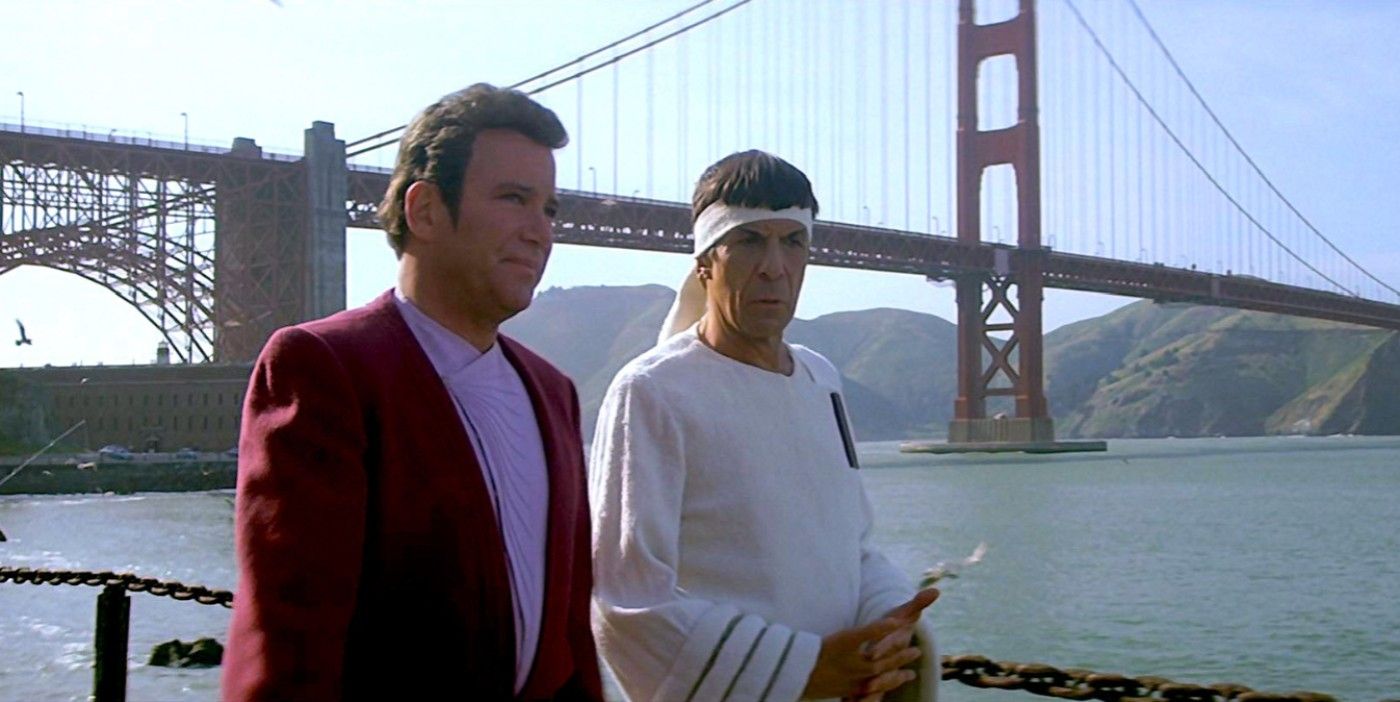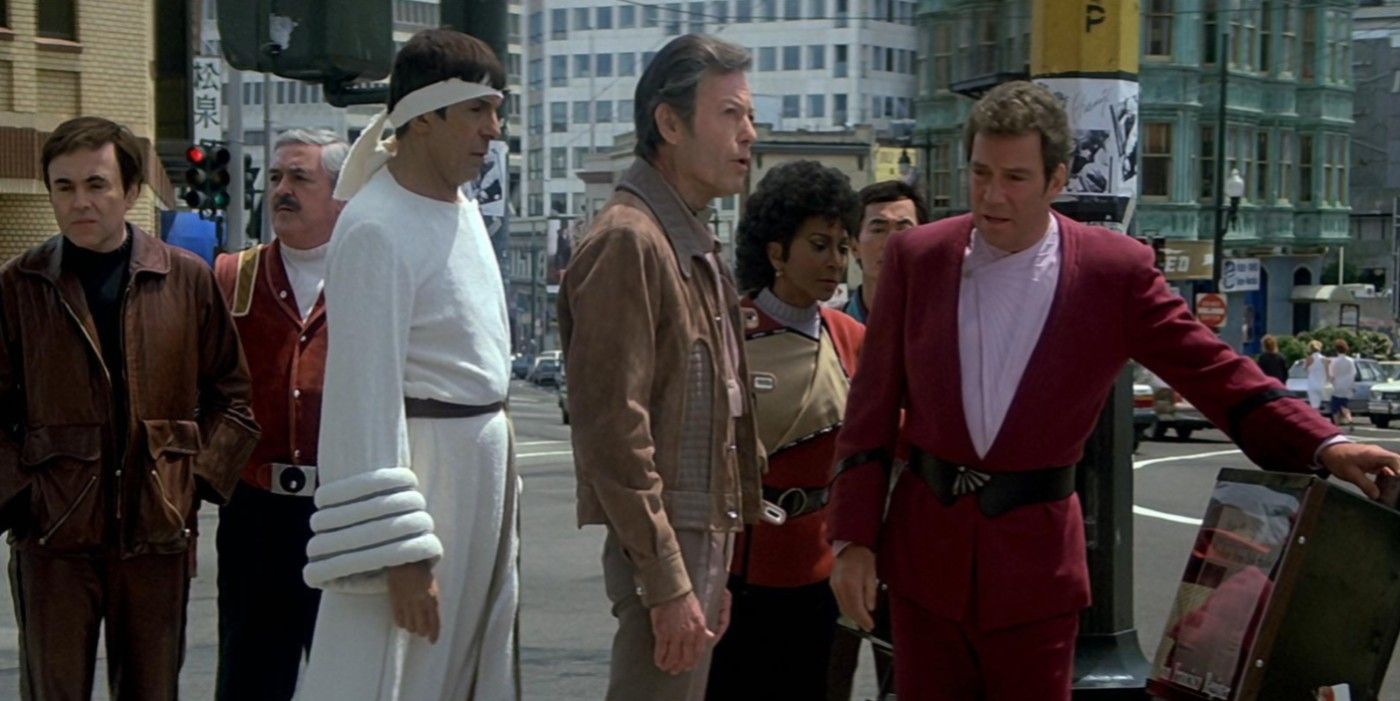Star Trek IV: The Voyage Home is the only Star Trek movie in which no one dies — a remarkable and admirable feat that makes it the best movie in the franchise to watch for pure enjoyment. The second film directed by Spock himself, Leonard Nimoy, who also conceived the story, Star Trek IV was the conclusion of the "trilogy" that began with the Vulcan's death in Star Trek II: The Wrath of Khan and continued with Spock's resurrection in Star Trek III: The Search for Spock. Released in 1986 and earning $109-million, The Voyage Home was the highest-grossing Star Trek film until J.J. Abrams' reboot in 2009.
Affectionately known among non-Trekkers as "the one with the whales," Star Trek IV's plot involves the crew of the now-destroyed U.S.S. Enterprise led by Admiral James T. Kirk (William Shatner) returning to Earth after their exile on Vulcan. When a mysterious probe arrives on Earth and begins to devastate the planet, Spock deduces that it's trying to find and communicate with humpback whales, which are extinct in the 23rd-century. Naturally, Kirk orders the only possible course of action: time traveling to 1986 to steal humpback whales and return them to their future time in order to save the world. What follows is a lighthearted, entertaining romp that hilariously plunges the intergalactic heroes into the late-1980s, where they are unavoidably fish-out-of-water, as they try to acquire the humpback whales and deal with various logistical problems before they can jump back to their proper era.
By design, and in accordance with Nimoy's wishes, no one dies in Star Trek IV, violently or otherwise. In fact, The Voyage Home is the only Star Trek movie where none of the franchise's signature weapons like phasers or photon torpedoes are fired at another person or starship with the intent to kill or destroy. Star Trek IV even celebrates life (human and cetacean) and the film includes a funny scene in a hospital where Dr. Leonard McCoy (DeForrest Kelley) gives an old lady dying of kidney dialysis a pill which magically grows her a new organ thanks to his advanced 23rd-century medical science. As Nimoy himself described his vision, the director wanted "no dying, no fighting, no shooting, no photon torpedoes, no phaser blasts, no stereotypical bad guy. I wanted people to really have a great time watching this film [and] if somewhere in the mix we lobbed a couple of big ideas at them, well, then that would be even better."
Thanks to Nimoy's unique anti-violence and no-deaths credo, The Voyage Home is a shining outlier in the Star Trek movie franchise. Every other film has involved the deaths of characters: Star Trek: The Motion Picture saw the demise of Will Decker (Stephen Collins) and Ilia (Persis Khambatta), Spock and Khan (Ricardo Montalban), among dozens of others, died in Star Trek II, and, in Star Trek III, Kirk's son David (Merritt Buttrick) was murdered by Kruge (Christopher Lloyd), who died along with the Genesis planet. Spock's brother Sybok (Lawrence Luckinbill) died at the end of Star Trek V: The Final Frontier and Star Trek IV: The Undiscovered Country's plot was kicked off by the assassination of the Klingon Chancellor Gorkon (David Warner).
Unfortunately, the four movies starring the cast of Star Trek: The Next Generation were steeped in death, including Kirk himself in Star Trek Generations. Numerous Starfleet Officers were assimilated by the Borg in Star Trek: First Contact, the villainous Ru'afo (F. Murray Abraham) violently perished in Star Trek: Insurrection, and Star Trek: Nemesis ended with the deaths of the evil Shinzon (Tom Hardy) and Commander Data (Brent Spiner). J.J. Abrams's trilogy of Star Trek movies upped the violence even further, with countless people dying in his 2009 reboot, Star Trek Into Darkness, and Star Trek Beyond.
There was certainly peril to be had in Star Trek IV since the whale probe was vaporizing the Earth's oceans, potentially dooming billions of lives. But Kirk, Spock, and their crew laudably conjured a peaceful solution to this crisis that didn't involve destroying the probe to save the world. Instead, Star Trek IV's heroes threw all of their cards into the movie franchise's craziest gambit that succeeded by both satisfying the probe's curiosity and giving humpback whales a chance to proliferate in the 23rd-century. For the Star Trek movies, it doesn't get better than that.


